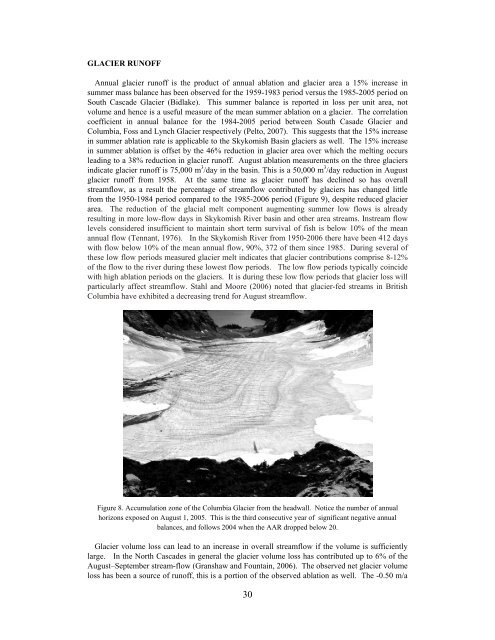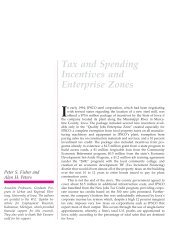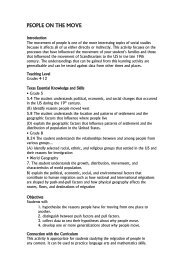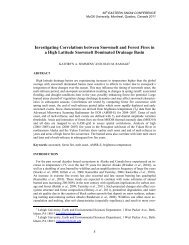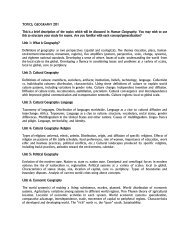Skykomish River, Washington Impact of Ongoing Glacier Retreat on ...
Skykomish River, Washington Impact of Ongoing Glacier Retreat on ...
Skykomish River, Washington Impact of Ongoing Glacier Retreat on ...
You also want an ePaper? Increase the reach of your titles
YUMPU automatically turns print PDFs into web optimized ePapers that Google loves.
GLACIER RUNOFF<br />
Annual glacier run<str<strong>on</strong>g>of</str<strong>on</strong>g>f is the product <str<strong>on</strong>g>of</str<strong>on</strong>g> annual ablati<strong>on</strong> and glacier area a 15% increase in<br />
summer mass balance has been observed for the 1959-1983 period versus the 1985-2005 period <strong>on</strong><br />
South Cascade <str<strong>on</strong>g>Glacier</str<strong>on</strong>g> (Bidlake). This summer balance is reported in loss per unit area, not<br />
volume and hence is a useful measure <str<strong>on</strong>g>of</str<strong>on</strong>g> the mean summer ablati<strong>on</strong> <strong>on</strong> a glacier. The correlati<strong>on</strong><br />
coefficient in annual balance for the 1984-2005 period between South Casade <str<strong>on</strong>g>Glacier</str<strong>on</strong>g> and<br />
Columbia, Foss and Lynch <str<strong>on</strong>g>Glacier</str<strong>on</strong>g> respectively (Pelto, 2007). This suggests that the 15% increase<br />
in summer ablati<strong>on</strong> rate is applicable to the <str<strong>on</strong>g>Skykomish</str<strong>on</strong>g> Basin glaciers as well. The 15% increase<br />
in summer ablati<strong>on</strong> is <str<strong>on</strong>g>of</str<strong>on</strong>g>fset by the 46% reducti<strong>on</strong> in glacier area over which the melting occurs<br />
leading to a 38% reducti<strong>on</strong> in glacier run<str<strong>on</strong>g>of</str<strong>on</strong>g>f. August ablati<strong>on</strong> measurements <strong>on</strong> the three glaciers<br />
indicate glacier run<str<strong>on</strong>g>of</str<strong>on</strong>g>f is 75,000 m 3 /day in the basin. This is a 50,000 m 3 /day reducti<strong>on</strong> in August<br />
glacier run<str<strong>on</strong>g>of</str<strong>on</strong>g>f from 1958. At the same time as glacier run<str<strong>on</strong>g>of</str<strong>on</strong>g>f has declined so has overall<br />
streamflow, as a result the percentage <str<strong>on</strong>g>of</str<strong>on</strong>g> streamflow c<strong>on</strong>tributed by glaciers has changed little<br />
from the 1950-1984 period compared to the 1985-2006 period (Figure 9), despite reduced glacier<br />
area. The reducti<strong>on</strong> <str<strong>on</strong>g>of</str<strong>on</strong>g> the glacial melt comp<strong>on</strong>ent augmenting summer low flows is already<br />
resulting in more low-flow days in <str<strong>on</strong>g>Skykomish</str<strong>on</strong>g> <str<strong>on</strong>g>River</str<strong>on</strong>g> basin and other area streams. Instream flow<br />
levels c<strong>on</strong>sidered insufficient to maintain short term survival <str<strong>on</strong>g>of</str<strong>on</strong>g> fish is below 10% <str<strong>on</strong>g>of</str<strong>on</strong>g> the mean<br />
annual flow (Tennant, 1976). In the <str<strong>on</strong>g>Skykomish</str<strong>on</strong>g> <str<strong>on</strong>g>River</str<strong>on</strong>g> from 1950-2006 there have been 412 days<br />
with flow below 10% <str<strong>on</strong>g>of</str<strong>on</strong>g> the mean annual flow, 90%, 372 <str<strong>on</strong>g>of</str<strong>on</strong>g> them since 1985. During several <str<strong>on</strong>g>of</str<strong>on</strong>g><br />
these low flow periods measured glacier melt indicates that glacier c<strong>on</strong>tributi<strong>on</strong>s comprise 8-12%<br />
<str<strong>on</strong>g>of</str<strong>on</strong>g> the flow to the river during these lowest flow periods. The low flow periods typically coincide<br />
with high ablati<strong>on</strong> periods <strong>on</strong> the glaciers. It is during these low flow periods that glacier loss will<br />
particularly affect streamflow. Stahl and Moore (2006) noted that glacier-fed streams in British<br />
Columbia have exhibited a decreasing trend for August streamflow.<br />
Figure 8. Accumulati<strong>on</strong> z<strong>on</strong>e <str<strong>on</strong>g>of</str<strong>on</strong>g> the Columbia <str<strong>on</strong>g>Glacier</str<strong>on</strong>g> from the headwall. Notice the number <str<strong>on</strong>g>of</str<strong>on</strong>g> annual<br />
horiz<strong>on</strong>s exposed <strong>on</strong> August 1, 2005. This is the third c<strong>on</strong>secutive year <str<strong>on</strong>g>of</str<strong>on</strong>g> significant negative annual<br />
balances, and follows 2004 when the AAR dropped below 20.<br />
<str<strong>on</strong>g>Glacier</str<strong>on</strong>g> volume loss can lead to an increase in overall streamflow if the volume is sufficiently<br />
large. In the North Cascades in general the glacier volume loss has c<strong>on</strong>tributed up to 6% <str<strong>on</strong>g>of</str<strong>on</strong>g> the<br />
August–September stream-flow (Granshaw and Fountain, 2006). The observed net glacier volume<br />
loss has been a source <str<strong>on</strong>g>of</str<strong>on</strong>g> run<str<strong>on</strong>g>of</str<strong>on</strong>g>f, this is a porti<strong>on</strong> <str<strong>on</strong>g>of</str<strong>on</strong>g> the observed ablati<strong>on</strong> as well. The -0.50 m/a<br />
30


